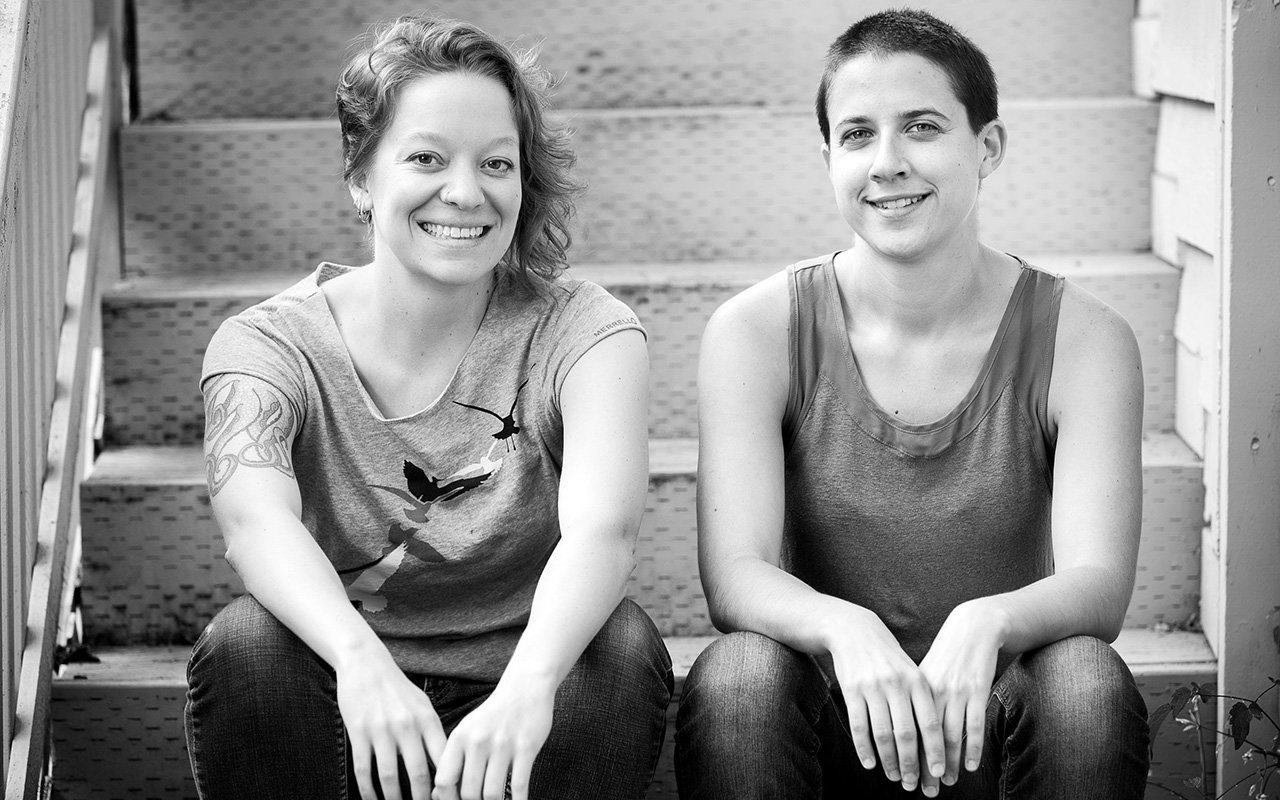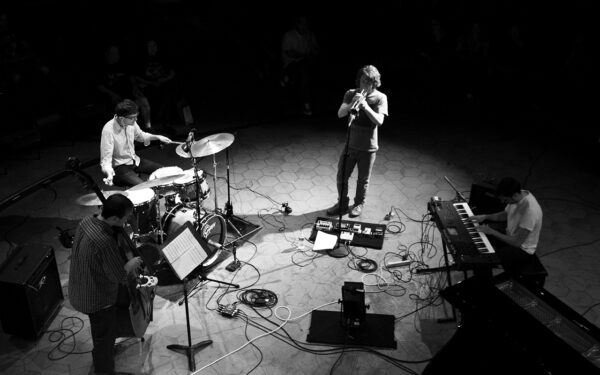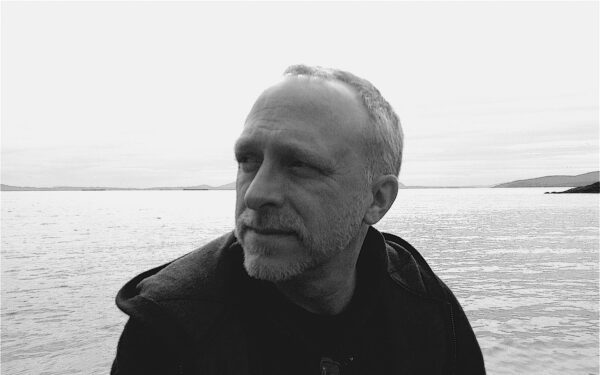
Syrinx Effect: Kate Olson and Siegel. Photo by Daniel Sheehan
Thursday, July 11 & 25
Chapel Performance Space
Welcome to the latest edition of Earshot’s juried series, Jazz: The 2nd Century. Early in June, a brilliant panel of five artists and presenters convened in the Earshot Jazz offices to listen to the 32 entries for this year’s series, and engage in the difficult but rewarding task of selecting four ensembles and one alternate for this year’s concert series. The panelists were not told the artist’s names until the final selections were made. All of the submissions were great.
This series – presenting Seattle artists, selected by a peer panel, performing original work, in a concert setting – is a continuation of the very first programming initiative of the Earshot Jazz organization, and embodies one of our core values. Earshot’s first concert series, New Jazz/New City, was mounted in the New City Theater, now the Richard Hugo House, on Capitol Hill in 1986. The series has continued each year since: as New Jazz/New City, the Earshot Spring Series, Voice and Vision, and now Jazz: The Second Century.
It has been gratifying over the years to hear all of this original work, both in the artistic submissions and on stages around Seattle. We are grateful to all of the panelists who have helped to curate these concerts and to the audience members who support them. And we are super proud to support this fantastic new work by Seattle artists. Thanks, too, to Nonsequitur’s Steve Peters for his support of the series in recent years.
Enjoy!
– John Gilbreath
Thursday, July 11, 7:30pm
Syrinx Effect | Chemical Clock
Syrinx Effect
Naomi Siegel (trombone, pedals, field recordings) & Kate Olson (saxophone, effects)
Syrinx Effect is an experimental platform for trombonist Naomi Siegel and saxophonist Kate Olson. The duo plays contemporary, improvised music with electronics. Olson mixes jazz licks and space on soprano sax above a layer of laptop effects, Buddha Machine loops, and snaps, pops and analog electronic sounds from a Cracklebox. Siegel explores the range and booms of trombone and lays down a background of looped brass thwarted by guitar pedals, plus field recordings from her travels.
The duo’s recent release Gnarly & Sweet shows their approach to improvised sonic journeys, tending to cinematic soundscapes set on droning rhythmic motifs. The two trade responsibilities in driving the shape and form of the pieces, each, at times, soloing minimally and sweetly or bombastically.
The duo recently returned from a short tour on the East Coast, from Boston to DC, and are frequent collaborators in Seattle.
Gnarly & Sweet is available at thesyrinxeffect.bandcamp.com.
– SH

Chemical Clock: (From left to right) Mark Hunter, Evan Woodle, Ray Larsen, Cameron Sharif. Photo By Andrew Swanson
Chemical Clock
Cameron Sharif (keyboard), Ray Larsen (trumpet), Mark Hunter (bass), Evan Woodle (drums)
Yet another band arising from Seattle’s embarrassment of avant-jazz riches, Chemical Clock is an aggressive and determined young band with a lot of good ideas and more than enough chops to pull them off. Led by keyboardist and composer Cameron Sharif, the quartet’s self-titled debut CD EP is a brief and refreshing blast of post-everything avant fusion. Keep in mind that the word “fusion” is a bit loaded. Fusion, to Sharif and his colleagues, means something very different than it did back in the 20th century. The combination of Ray Larsen’s electric trumpet and Shari’s electric keys might suggest a set inspired by Miles Davis’ Bitches Brew (Columbia, 1969) – but while such influences are unavoidable, Chemical Clock is not about reinterpreting or regurgitating the past. Indeed, there is very little nostalgia going on here. The fusion here encompasses aspects of jazz, electronic dance music, prog-metal, contemporary classical music, and the indefinable electro-acoustic music currently being explored by edgy rock bands such as Lightning Bolt and Hella.
– Dave Wayne
Reprinted with permission. Copyright 2013 AllAboutJazz.com and Dave Wayne.
Thursday, July 27, 7:30pm
Eric Ring | Paul Kikuchi’s Autonomic Chamber Ensemble

Eric Ring Photo By Beth Farrow
Eric Ring
Pianist Eric Ring and jazz peers, including trumpeter Jim Knodle, made an impact on Seattle’s late 80s and early 90s scene. At that time, Ring, Knodle, bassist Doug Lilla and drummer John Lavin, in the trio Circular Cowboys, struck Earshot Jazz writer Bruce Kochis: “Cool, cerebral, lightly swinging, spare – this kind of music reminds me of the MJQ with its abstract, geometrical design.”
In recent months, Ring’s re-joined his contemporaries, plus drummer Jeff Ferguson, in jams and hangs in White Center–West Seattle bars Mac’s Triangle Pub, the Shipwreck Tavern (recently closed) or Duos.
Ring’s Second Century submission, solo piano, shows the pianist in pensive mode. He writes: “This music is an exploration of texture, voicing and song in small compositions … these pieces are deliberately quiet.”
– SH

Paul Kikuchi Photo By Allen Glass
Paul Kikuchi’s Autonomic Ensemble
Paul Kikuchi, composition and percussion; Taina Karr, oboe; Emma Ashbrook, bassoon; Kate Olson, bass clarinet; Alex Guy, viola; Natalie Mai Hall, cello; John Teske, contrabass
Paul Kikuchi is a percussionist, composer, educator, instrument inventor and builder and Feldenkrais practitioner. He has performed in collaborative projects from large to small, with Wally Shoup, Stuart Dempster, others, and solo, in site-specific works; he’s the artistic director and founder of Prefecture Records; he’s held residencies at Centrum, near Port Townsend, and at the Montalvo Arts Center, California; he’s the recipient of awards and grants from Artist Trust, Chamber Music America, 4Culture, American Composers Forum, the Jack Straw Foundation, Seattle Office of Arts & Culture. As an undergrad, Kikuchi sought out rhythm great Milford Graves at Bennington College, at the suggestion of drummer Gregg Keplinger, who helped set Kikuchi up with his earliest drum kit. From Bennington College, Kikuchi eventually pursued a master of fine arts from the California Institute of the Arts African American Improvisational Music program led by Wadada Leo Smith, of the Association for the Advancement of Creative Musicians (AACM). The emphasis on interdisciplinary arts from that program continues to be part of Kikuchi’s artistry.
He writes, in his Second Century submission: “The next stage of jazz music is not a stage. Jazz is a continuum. It is the continued effort of those devoted to musical exploration through improvisation, dialogue, form, freedom and the joy of creating. Jazz is the individuals who make it, who continue the search.”
– SH
Tickets are $5-$15, sliding scale, at the door.